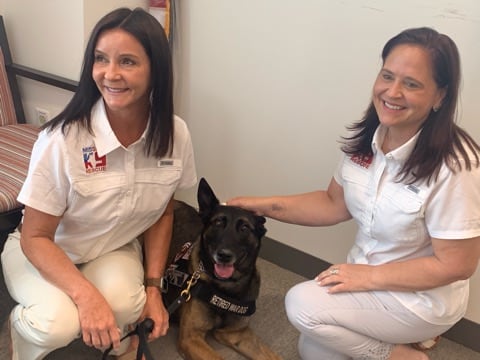Not all veterans walk on two legs.
The State Department’s Office of Weapons Removal and Abatement has been overseeing a program that trains military dogs to detect explosive devices such as mines and improvised explosive devices. Dozens of canines have been sent to places like Iraq and Syria to sniff out explosives, and their efforts have helped make those areas safer for humans and animals alike.
Three of those dogs just returned to the U.S. from Iraq and are currently being rehabilitated for adoption by Mission K9 Rescue, a nonprofit partner of the State Department that teaches service dogs how to be house pets once they are retired from duty.
“These dogs have served our citizens, our first-responders, our soldiers, our men and women on the front line,” said Kristen Maurer, Mission K9 Rescue’s president and founder. “They’re out there saving lives every single day. They’ve done this their whole lives, and it’s their time to retire and our time to give back to them.”
The three dogs in question — Der, Rhino and Rambo, all of who happen to be four-year-old Belgian Malinois — are all currently enjoying their own 30-by-30 plots of land on Mission K9 Rescue’s ranch in Houston. The goal is to get them ready for adoption as quickly as possible.
“It’s kind of like a dog paradise,” said Mollie Davis, a State Department public engagement and partnerships specialist. “These three guys here have [earned] a soft spot from all of us in this office … It’s a really exciting project and something that makes us feel really good.”
Jerry Guilbert, chief of programs in the Office of Weapons Removal and Abatement, said dogs have been frequently deployed to Iraq and Syria to identify the booby traps set up by the Islamic State. These dogs can sniff explosive devices from outside of buildings, which at least partially minimizes the danger to themselves and their human coworkers.
With the help of these animals, 80,000 explosives have been cleared in areas of Iraq and Syria that were liberated from the Islamic State’s control, according to Guilbert. Their work has been essential as the military attempts to restore vital services to these cities, including clean water, electricity, schools and hospitals.
Guilbert could only recall one explosive-sniffing dog who was killed in action while deployed.
“That’s because they’re really good at what they do,” he said. “And the training regiments that make these dogs so effective are highly effective.”

Now that their watch has ended, Der, Rhino and Rambo are being reminded how to act in a non-military setting via Mission K9 Rescue.
“We do the best we can to make them feel safe … and make them feel secure, learn what their triggers are and try to work around them,” said Louisa Kastner, Mission K9 Rescue’s vice president.
Kastner said that the training each dog receives depends on what the organization perceives to be their biggest obstacle toward adoption. That could mean a variety of things, including a need for them them to be less aggressive toward toys, less timid around loud noises or more comfortable around other dogs.
Once Mission K9 Rescue deems them ready for adoption, anyone interested will have to go through a strict application process to prove themselves worthy dog parents. That includes making sure that the prospective owner isn’t looking for a service dog, according to Kastner.
“These dogs have served, and a lot of them have PTSD themselves,” she said. “We want them just to have a retirement. We don’t want them to have to go to work again.”
Despite the difficulties involved in re-acclimating military dogs to a more relaxed civilian environment, Kastner isn’t worried about getting these dogs adopted.
“I don’t think it’ll be hard at all,” she said. “I think it’s just a matter of finding the right home.”




